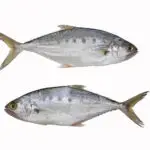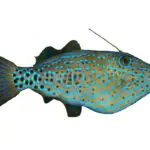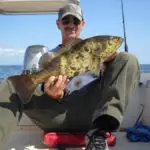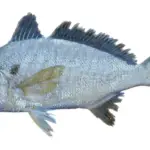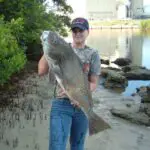Ask any seasoned angler their favorite live bait for catching big and powerful gamefish…and you are likely to hear: Pinfish.
In this article were going to cover exactly what fish you can catch with pinfish, and tips for targeting each species.
Let’s dive in!
Table of Contents
- What Can You Catch With Pinfish?
- Are Pinfish Good Bait?
- Why Are Pinfish So Popular for Bait?
- What Are the Popular Ways To Use Pinfish As Bait?
- Related Posts
What Can You Catch With Pinfish?
One of the top reasons that anglers use pinfish is that they are extremely versatile in attracting sought-after game fish. Snapper, Mackerel, Grouper, Tarpon, Redfish, and Snook will all eat pinfish, making them one of the best live bait choices for anglers.
Perhaps the better question is…what kind of fish doesn’t eat pinfish, ha!
Let’s take a closer look at what you can catch with pinfish:
Snook
The Snook is often referred to at the “King Fish” in the Gulf of Mexico and Atlantic coast. They’re my absolute favorite inshore fish to target!

This large beautiful gamefish is well known for being extremely elusive, and being very particular with bait choice.
Tips
Snook can be very picky when it comes to live bait, so patience is a virtue. I prefer to use a simple live bait rig, with no weight if possible.
A nice 4″ live pinfish hooked through the nose on a 4/0 circle hook, freelined under a dock or along a seawall is deadly!
Let the pinfish swim naturally…and be as quiet as possible. If a snook is in the area…she will find it, so be ready!
Grouper
There are dozens of different species of grouper living between Florida and Mexico and up the Atlantic coast.
Goliath, Snowy, Warsaw, Yellowfin, Red, and Black Grouper being some of the most common and sought after. These massive fish are well known to feed on pinfish year round!
Tips
Grouper have very large mouths, so this is the time to use the BIG Pinfish! Be sure to use heavy gauge circle hooks, and a strong leader.
Hook your pinfish under the dorsal fin, or in the nose and drop them down. Try and hold them 1-3 feet above the structure, otherwise, they are likely to swim into the rocks and get snagged.
Snapper
There are many different types of snapper, and all of them eat pinfish as a part of their regular diet.

Mutton, Yellowtail, Cubera, Mangrove, and Red Snapper are all common game fish, and pinfish are used to target all of them!
Tips
Live pinfish are excellent bait for snapper, especially if you are fishing over a reef or from an elevated position such as a bride or jetty.
Use a 4/0-6/0 circle hook on a simple knocker rig with 1-3 ounces of weight. I like to hook my pinfish in the top of the back when fishing for snapper. Drop em’ down and hang on!
Tarpon
Tarpon are well known throughout the world as some of the strongest and most powerful fish an angler can hook. Tarpon are especially common throughout the Florida Keys, and pinfish make perfect live bait when fishing for Tarpon.
Tips
When targeting Tarpon with live pinfish you have a few different options. The simplest and most effective is a simple live bait rig, that is freelined. This works well in areas with little current (such as flats, and backwater bays).
Another option is to slow troll live pinfish, especially in the summer months when tarpon are on the beaches. Be sure to use a fluorocarbon leader and give yourself plenty of line!
Mackerel
The Gulf of Mexico is home to Cero and Spanish Mackerel, as well as the more sought-after King Mackerel.
All three species of Mackerel are plentiful in this, and pinfish are one of the best live bait options for targeting them.
Tips
Slow trolling is pinfish is popular when targeting mackerel. Use a steel leader, and always hook the fish in the nose or top of the mouth when trolling to prevent it from spinning.
Redfish
Redfish are a common saltwater fish that are fairly easy to catch and provide great meat for cooking. Shrimp, pigfish, and pinfish are the three most common types of bait used for catching Redfish, provided that the bait fish are not too large in size.
Tips
Redfish are not very picky eaters, and will readily take a live pinfish, dead pinfish or even cut bait!
Due to their smaller mouths, you want to be sure you use pinfish no bigger than 4-5 inches or cut them into chunks.
When targeting redfish, I always use a 2/0-4/0 circle hook and fish them on the bottom. That’s where redfish primarily feed.
Spotted Sea Trout
Spotted Sea Trout are one of the most common species of inshore fish throughout the Gulf of Mexico and along the Southeast.

Ever seen the fish on a big spotted sea trout? Trust me, they have no problem with pinfish and love them all year long!
Tips
No need to use big pinfish when targeting Spotted Sea Trout. In fact, this is the one species that loves smaller pinfish, 2-4 inches in size.
I like to use a 1/0 or 2/0 circle hook, and fish hook my pinfish through the nose. Freelined or slow trolling over deep grass flats can be very effective.
Another option is to put them under a Cajun Thunder poppin’ cork, which is a great visual indicator and noise maker to attract a bite.
Jack Crevalle
The mighty Jack Crevalle! Perhaps one of the hardest pound-for-pound fighting fish that swims. These behemoths are not picky eaters, and will eat big, small, live or dead pinfish all year long!
Tips
There really isn’t a wrong way to fish a pinfish for Jack Crevalle. Although, live bait seems to perform the best. Use as little weight as possible, most Jack crevalle feed in the upper part of the water column or along the surface (especially along the beaches). .
See Also: 3 Fail-Proof Rigs for Jack Crevalle (With Easy Instructions)
Cobia
Cobia are prized by anglers all over the world for their powerful fighting ability, large size and delicious taste. Having a baitwell full of live Pinfish can mean the difference between seeing a cobia, and actually getting one to bite.
Tips
The best time of year to target Cobia with pinfish is during the late winter or early spring Cobia run. These fish migrate up and down the coastal states, often following large Manta Rays or Sea Turtles.
Have a rig ready; I like to use a 5000 series spinning reel on a medium-heavy rod, with a 60-pound leader and a 5/0 circle hook.
If you happen to see some cobia, it doesn’t really matter where you hook your pinfish. Just get it in the water and in front of them, fast! They will not resist a live pinfish!
Sharks
Shark fishing has really grown in popularity over the last 10 years or so, and not just fishing for the big ones on the beach.

Juvenile Bull sharks, Lemon sharks, and Blacktips are prevalent along inshore and coastal waters and love to feed on pinfish. They are a lot of fun to catch!
Tips
If you’ve ever had trouble keeping your pinfish alive, this is the time to put those dead baits to good use.
Hook your dead or frozen pinfish on a large 4/0-8/0 circle hook, and fish it on the bottom with enough wait to keep it in place. Be sure to use a steel leader if you want to target sharks…otherwise, they won’t be hooked for long before biting through your line.
Other Species
Does that mean that the above-listed species are the only fish that eat pinfish?
No way!
Tons of other fish eat pinfish, including bluefish, permit, black drum, flounder, stingrays, and many more!
You May Also Like: 5 Ways To Hook Mullet For Bait & Increase Your Hook Sets
Are Pinfish Good Bait?
Pinfish are a fantastic bait choice when targeting inshore and nearshore gamefish. They are a natural food source for some of the most popular saltwater fish and can be fished in a variety of ways.
Pinfish make good bait for a variety of reasons, the first being effectiveness. Pinfish flat out have a reputation to catch big fish and are known to be a favorite of the elusive snook and many other nearshore species.
Pinfish are fairly sturdy fish that can survive a long time in bait pens, and they are very active on the hook.
Another factor that makes pinfish a fantastic live bait option is that they are readily available.
Any angler with a bait trap and access to coastal waters is capable of catching pinfish with very little effort, and it is also easy to fill up a bait tank by using a cast net.
Why Are Pinfish So Popular for Bait?
Pinfish are extremely popular primarily because they work! Almost all of the game fish that saltwater anglers fish for can be caught using pinfish, and they are also very common and readily available. Pinfish are easily trapped and caught using bait traps and cast nets.
Anglers who like to plan ahead will often set up a pinfish trap the night before in the area they will be fishing the next day.
A properly baited pinfish trap set out the night before fishing will provide fresh and feisty live bait the following morning.
And because pinfish eat everything from shrimp and clams, to bread and dog food, they are easy to catch on a hook and line too!
What Are the Popular Ways To Use Pinfish As Bait?
The most popular method of using pinfish is on the hook as live bait. They are most often kept in bait wells, buckets, and bait pens and are very active on the hook. Pinfish can also be used on a trolling line behind a boat, as well as being used as cut bait.
Pinfish are most often put onto the hook live, either through the back, tail, nose, or lips.
Regardless of how they are hooked, pinfish make for very durable and reliable bait fish. They produce enough action to attract predator fish and release plenty of scent into the water.
Pinfish can also be used as cut bait, and even frozen to be stored away for a later date.
It is less common for pinfish to be used this way, however, as their small size makes them an inefficient choice for most scenarios.
For these reasons, pinfish are best used as live bait for gamefish.
You May Also Like: The Complete Guide To The Florida Mullet Run
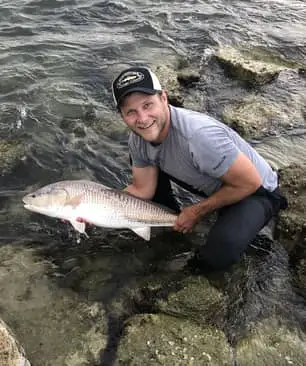
Growing up in Florida, I’ve been surrounded by saltwater my entire life…and I love sharing my passion with others.
To learn more about why I started Saltwater Mecca, visit the ABOUT page.
Thank you for reading this article. Browse around & have some fun!

